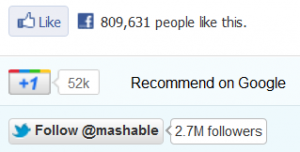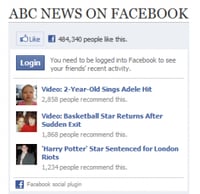Marketing Analytics Strategist
5 questions about optimizing social presence on your website
Marketing Analytics Strategist
Buttons to social presences are increasingly present on websites. However, many questions are raised about their usefulness, where to place them and how to optimize them.
To answer these questions, Karim, social media specialist , and Maïlys, customer experience specialist , offer their expertise on this popular practice.
DO WE ABSOLUTELY HAVE TO PUT BUTTONS TO SOCIAL PRESENCES ON A WEBSITE?
Karim: If you run social media accounts, it is imperative to put buttons to your social presences on your website for three main reasons:
- Increase the visibility of your social presences: Social media buttons allow your site visitors to discover that you are present on social media and find your presences easily.
- Increase the number of subscribers to your social presences: Your publications will thus reach more users, which will increase the potential for interactions and sharing of your content.
- Create a long-term relationship with your visitors: By subscribing to your social presences, users will see several of your publications periodically, which will increase their commitment to your organization. Posts with a call-to-action will also inspire them to revisit your website, discover your content, or even visit you in-store.
Thus, social media buttons are used to transform a single visit to your website into a long-term relationship between you and the Internet user, which will partly make profitable the efforts and the money spent to bring it to your site in the first place.
Maïlys: For our part, we are now increasingly encouraged by our SEO experts to make the social presence buttons very visible on the sites on which we work. Logically, the greater the number of subscribers, the more the content is likely to be shared.
The important thing is to plan from the start of the project how much social media should be highlighted, otherwise they will systematically become secondary in relation to the other elements of the site.
ARE THERE WAYS TO DISPLAY MORE RECOMMENDED SOCIAL PRESENCE BUTTONS THAN OTHERS?
M and K: In fact, we will often push towards the "official" buttons, i.e. those provided by social networks, because of their advantages:

Advantages
- Use little space
- Allow to better measure the performance of the site as a source of traffic, thanks to Facebook Insights/Open Graph
Disadvantages
- “Force” Internet users to engage without knowing in advance the content of social presences
Official Button Best Practices
Official buttons allow the concept of “social proof” to be used, whereby users assume that the actions of others reflect the correct behavior and will therefore follow suit.
This gives in practical applications:

- Show follower count:
Facebook automatically includes the subscriber counter in the configuration of its “Like” button, while Twitter displays it by default for “Follow” but allows the possibility of removing it, as do Linkedin, Pinterest and StumbleUpon.

- Show friend photos:
According to Facebook, buttons with a face generate about 8 times more clicks than buttons without. And we see it less often, but the Google +1 button also has the option to display photos of friends since August 2011.
Other alternatives:
![]()


Images of Plugins Plugins icons appearing on mouseover
It is possible to consider other alternatives depending on the place you want to give to social presences on the site (the plugins require a lot of space for example), the possibilities of customization and the ease of integration.
WHERE SHOULD I BEST PLACE MY SOCIAL PRESENCE BUTTONS?
M: There isn't really a guide for “social presences”, but the three places where you find these kinds of buttons the most are at the top of the page, in the right column or at the bottom of the page.
Afterwards, it will depend a lot on the will and the capacity of the client in social media strategy.
If the presences are strong and important, as for news sites, we will place buttons at the top of the page and at the bottom of the page for example; on e-commerce sites where the call to action must be more secondary, we are going to place them only at the bottom of the page.
K: From a social strategy point of view, the ideal would be to have social media icons immediately visible (above-the-fold) to increase the visibility and the number of subscriptions of social presences. It would also be preferable for the icons to be present on all the pages of the site so that a visitor landing on any page of the site is encouraged to follow the social media accounts.
ARE THERE RULES TO FOLLOW TO OPTIMIZE THE NUMBER OF CLICKS ON MY SOCIAL PRESENCE BUTTONS?
M and K: A good practice that we try to apply is to explain the advantages of “liking” the page, as one could do for a newsletter. Benefits can be, for example, contests, exclusive offers or discounts.

Indeed, as a Usabilla study on user testing puts it , “The learning here is that if you are asking your users to like your product and be friends on Facebook, there needs to be a viable reason for them to do so, such as a contest, discount or special offer – and it needs to be explained.”
WHAT SOCIAL PRESENCES TO DISPLAY ON THE WEBSITE?
K: It depends on your social media strategy, your audience and the activity of your different accounts. First, the icons should be placed in order of platform importance according to your strategy and your audience. If you want your visitors to follow you mainly on Facebook, put this icon first.
Furthermore, we do not necessarily recommend displaying all of a company's social presence on its website. The rule to follow should be to display only accounts that will really bring added value to users.
For example, if you have created a Google + page that you never animate, this one brings no value to your visitors and should not be displayed. However, if you are active on Foursquare, even though it is a smaller platform, it brings real value to users and should be visible on your website.
M: In general, we try to reduce the number of calls to action to guide the user to the most important action. We also find that sites have an average of 2-3 social media buttons. So be careful to know your users well!
AND YOU WHAT DO YOU THINK?
Ergonomists, social media specialists, strategists and Internet users, what do you think? Do you have any favorite practices when it comes to social presence buttons, and which ones?
-2.png)






